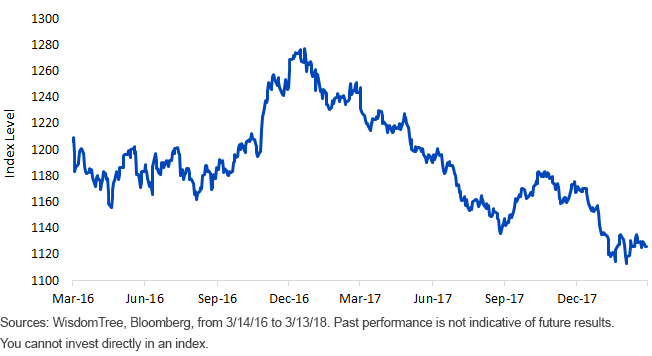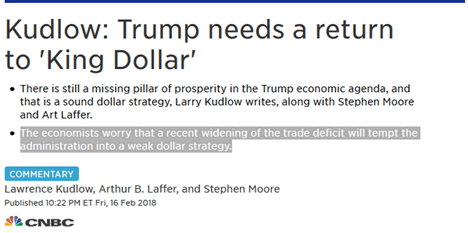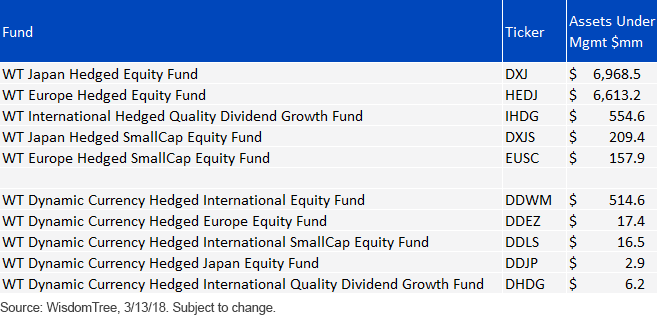A Return to King Dollar Policy: Implications


One of the most important macro stories of the last 15 months has been the dramatic decline in the U.S. dollar. This has helped spur international equity indexes that package foreign currency returns on top of the equity investments.

When looking at historical factors that drive currency movements, interest rate differentials are important, and the recent environment has been one in which the U.S. Federal Reserve (Fed) has been hiking interest rates, while the major developed market central banks in Europe and Japan have kept short-term rates in negative territory. This makes the collapse of the dollar all the more interesting and perhaps surprising.
The best explanation for what has been happening, in our view, is really politically motivated uncertainty around whether U.S. policy actions were going to favor a weaker dollar environment with reduced capital flows and investments into the U.S.
The changing of the guard in the White House, with the departure of Gary Cohn as Trump’s primary economic advisor and the insertion of Larry Kudlow, may be ushering in a very important strategic change in the currency markets and sentiment. In February, Kudlow and fellow authors Stephen Moore and Art Laffer authored the following story:

Some excerpts from Kudlow’s article:
The Trump Administration and the Republicans in Congress have passed one of the best pro-growth tax bills ever. The Tax Cuts and Jobs Act ranks in the all-time hall of fame of legislation, along with Ronald Reagan's 1981 and 1986 Tax Acts and John F. Kennedy's posthumous tax cuts of 1964. …
When this is combined with President Donald Trump’s deregulation agenda, we see no reason why the economy cannot grow for a sustained period at 3 to 4 percent growth—up from 1.6 percent in Obama’s last year. But there is still a missing pillar of prosperity in the Trump economic agenda, and that is a sound dollar strategy.
The dollar weakened in 2017 and we want it stabilized. …
… under Reagan the U.S. dollar increased by 67 percent in value on foreign exchange markets through 1985. The price of gold, interest rates, and inflation all fell as well from double-digit inflationary highs, while the American economy reignited and the stock market launched its 18 year bull market.
Or, go back further in time. In May of 1962, President Kennedy's Revenue Act was passed and he reaffirmed that the U.S. dollar was as good as gold—thus launching the incredible boom called the 'Go-Go Sixties'.1
A change in tone from the White House economic team that welcomes a strong dollar environment could challenge those in the international investing world, many of whom are exposed to foreign currency risk when sending their international investments overseas.
In 2017, the ETF industry saw more than $460 billion in ETF flows—$160 billion of that went to international equities, approximately $120 billion into the developed world and $40 billion into emerging markets. All of these ETF flows went into strategies that package currency risk on top of the foreign equities—as there was net $2.5 billion in outflows from international equity ETFs that hedge currency risk to focus on the international equity component of the returns.2
Don’t Bet on Currencies
WisdomTree was the first ETF issuer to advocate that currency risk has no expected return—sometimes the dollar weakens (as it has over last 15 months) and sometimes the dollar strengthens, but investors often have no idea which direction the dollar is going to move. Many investors believe the discussion to mitigate currency from the table by hedging is an “active call,” but from a pure exposure perspective, unhedged strategies have two levels of exposure (stock plus currency) and are actually making an active directional call. Hedging tries to remove any directional calls from the equation.
WisdomTree believes currency adds to expected risk in broad international settings and for most markets. Japan is an outlier over the last 20 years. Its currency and equities were so negatively correlated that yen weakness was almost a necessity for positive equity returns, but because the yen and Japanese stocks moved in different directions, the yen was a “dampener” in volatility—a weak yen ate away at the returns when the market was going up, and a strong yen cushioned declines in stocks as the rising yen often was a catalyst for falling stocks.
We have tried to make investors more aware of the currency bets embedded in their unhedged strategies and that hedging helps investors move to being net neutral and more indifferent to currency movements.
With Kudlow, a strong advocate for a stable and strong U.S. dollar, entering the White House, now would be a good time to review your own currency thought process.
Why Invest Abroad?
Are you investing overseas because you want equity diversification and see the stocks as reasonably or better priced than U.S. equities? If so, why would you want to bet that the dollar will decline, as most investors default to with unhedged strategies?
Dynamic Currency Hedging
Since we launched our strategic and 100% currency-hedged strategies starting in late 2009, we have pushed the innovation curve further to incorporate a currency factor model that uses three signals to determine how much currency exposure to hedge. Those signs are based on momentum, value and interest rates.
Just like many have focused on “smart beta” as a factor investing strategy, we think of a dynamic currency-hedging approach as “smart hedging” to hedge when the odds are more in your favor of the hedges paying off. We believe over time this currency factor approach can add value over unhedged, fully hedged and half-hedged benchmarks if there are enough currency cycles to capture—say, over three- to five-year periods.
Whether one moves to a more currency-neutral allocation using fully hedged strategies or a dynamic approach to managing currency risk, we believe now is a good time to consider various options for international equities.
Learn more about our different currency hedged ETFs and strategies.

1Lawrence Kudlow, Arthur B. Laffer and Stephen Moore, “Kudlow: Trump needs a return to ‘King Dollar,’” CNBC, 2/16/18.
2Sources: WisdomTree, Bloomberg, 12/31/17.
Important Risks Related to this Article
There are risks associated with investing, including possible loss of principal. Foreign investing involves special risks, such as risk of loss from currency fluctuation or political or economic uncertainty. Funds focusing their investments on certain countries, sectors and/or smaller companies may be more vulnerable to any single economic or regulatory development. This may result in greater share price volatility. Investments in currency involve additional special risks, such as credit risk and interest rate fluctuations. Derivative investments can be volatile, and these investments may be less liquid than other securities, and more sensitive to the effects of varied economic conditions. Derivatives used by the Funds may not perform as intended. The dynamic currency Funds invest in derivatives in seeking to obtain a dynamic currency-hedge exposure. The composition of the Index underlying each dynamic currency Fund is heavily dependent on quantitative models and data from one or more third parties, and the Index may not perform as intended. The Funds invest in the securities included in, or representative of, their Indexes regardless of their investment merit, and a Fund does not attempt to outperform its Index or take defensive positions in declining markets. Please read each Fund’s prospectus for specific details regarding the Fund’s risk profile.

Jeremy Schwartz has served as our Global Chief Investment Officer since November 2021 and leads WisdomTree’s investment strategy team in the construction of WisdomTree’s equity Indexes, quantitative active strategies and multi-asset Model Portfolios. Jeremy joined WisdomTree in May 2005 as a Senior Analyst, adding Deputy Director of Research to his responsibilities in February 2007. He served as Director of Research from October 2008 to October 2018 and as Global Head of Research from November 2018 to November 2021. Before joining WisdomTree, he was a head research assistant for Professor Jeremy Siegel and, in 2022, became his co-author on the sixth edition of the book Stocks for the Long Run. Jeremy is also co-author of the Financial Analysts Journal paper “What Happened to the Original Stocks in the S&P 500?” He received his B.S. in economics from The Wharton School of the University of Pennsylvania and hosts the Wharton Business Radio program Behind the Markets on SiriusXM 132. Jeremy is a member of the CFA Society of Philadelphia.

